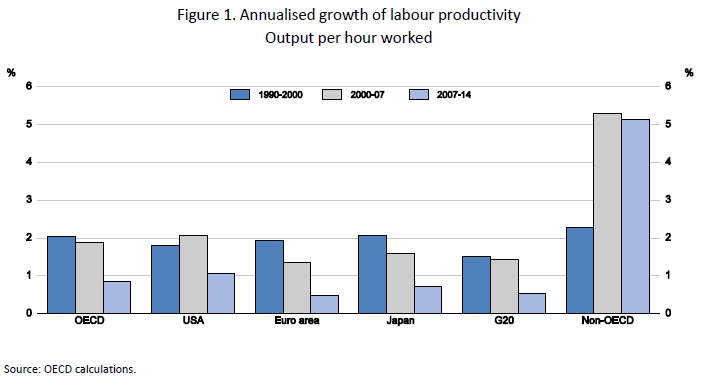Structural reforms to revive growth in Europe: necessary but not sufficient
By Aida Caldera Sánchez, European Union Desk, and Nicolas Ruiz, Structural Surveillance Division, OECD Economics Department
After many years characterised by output losses or quasi-stagnation, steadier growth appears to be setting in across European economies. Recent data point to an upturn in growth, the euro-area unemployment rate has finally fallen below 10%, and private-sector confidence has strengthened. Yet, there is still a need to address the consequences of the crisis, as unemployment remains high, and sizable non-performing loans continue to be a constraint in some countries. Moreover, one challenge that basically all governments face is the sharp slowdown in productivity. Productivity – a central ingredient in the pursuit of growth and well-being – has been decelerating in most European economies. The slowdown has been particularly sharp since the crisis but was already noticeable before, suggesting that structural factors may lie behind the downward trend (Figure 1).

To address these challenges, structural reforms are necessary but not sufficient to restore robust growth in Europe. This is why the OECD advocates for a three-pronged approach (OECD, 2016a). First, existing exceptional monetary measures should continue in the euro area until inflation reaches target, albeit the scope to continue the stimulus or to move beyond existing plans is now very limited. Second, more active fiscal policy is needed to support aggregate demand and boost potential output. Third, these macro-policies should support an enhanced and efficient implementation of structural reforms.
Indeed, fiscal policy should take advantage of the increase in fiscal space provided by low interest rates to boost growth, equity, and productivity, including via enhanced hard and soft infrastructure investment and other tax, spending, and structural measures that support growth and potential output. Fiscal policy should do more to support growth, possibly by easing the application of the EU Stability and Growth Pact within existing rules, for example by making it easier to exclude net investment spending from fiscal rules (OECD, 2016a). Collective fiscal efforts would have greater impact than individual efforts. Combined with bold and coherent collective actions on structural reforms to strengthen Europe’s economic fabric, the gains from fiscal action would be magnified. In short, the gains would be more than the sum of the parts.
On the structural reforms front what needs to be done? The EU Single market remains far from completed, and the 2016 OECD Economic Survey of the European Union (OECD, 2016b) makes recommendations to reinvigorate it:
- Capital markets are fragmented, and firms are over-dependent on bank financing. Improved securitisation, better collection and sharing of credit information on SMEs and harmonization of insolvency regimes would help expand and diversify sources of financing and help sustain the recovery.
- Labour mobilitywould profit from reduced administrative and regulatory barriers, such as faster recognition of professional qualifications and better portability of social and pension rights.
- Product market reforms would help to unlock investment. National regulations and technical specifications in network sectors, such as energy and transportation, should be harmonised further. Regulatory burdens could be alleviated by better impact assessment of legislative proposals and ex-post policy evaluation. Projects to improve trans-European transport and energy grids should be prioritised.
Structural reforms are needed but they also need to be designed coherently. A bigger bang for the buck will be ensured if reforms are implemented through articulated and coherent policy packages that maximise synergies across areas. A review of the evidence suggests that simultaneous reforms of labour and product markets are typically more growth enhancing than isolated reforms (Caldera Sánchez et al., 2016). Over the last two years, however, such reform packages have not been the norm. For example, reforms have been undertaken either in the labour market or product markets, but very rarely in both (Figure 2). An example is Greece, where much of the adjustment has been borne by workers, while monopoly power and barriers to entry have remained in place in many sectors (OECD, 2016c). Better coordination of reforms across different areas would ease implementation and maximise the favourable growth and job impact of structural reforms.

References
Caldera Sánchez, A., A. de Serres and N. Yashiro (2016), “Reforming in a difficult macroeconomic context: A review of the issues and recent literature”, OECD Economics Department Working Papers, No. 1297, OECD Publishing, Paris. http://dx.doi.org/10.1787/5jlzgj45b3q0-en
OECD (2016a), OECD Economic Outlook, Volume 2016 Issue 2, OECD Publishing, Paris.
http://dx.doi.org/10.1787/eco_outlook-v2016-2-en
OECD (2016b), Economic Surveys: European Union 2016, OECD Publishing, Paris. http://dx.doi.org/10.1787/eco_surveys-eur-2016-en
OECD (2016c), OECD Economic Surveys: Greece 2016, OECD Publishing, Paris. http://dx.doi.org/10.1787/eco_surveys-grc-2016-en